So you've decided to get into mechanical keyboards
This is a dangerous path you're about to walk down. Is your wallet ready?
Whether you prefer the smooth glide of linear switches, the gentle bump of a tactile switch or the full-on audio assault of a clicky switch, there’s something extremely gratifying about typing on a mechanical keyboard (even if it’s just a reply to someone who is wrong on the internet). And it’s even better if it looks as adorable as this.
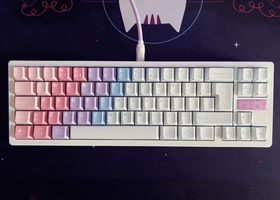
I’ll level with you: I got into mechanical keyboards because a) they’re so PRETTY! and b) it was the pandemic, what else was I supposed to do? I had been perfectly happy tapping away on my Apple wireless keyboard for a very long time. But I really do prefer them now, and find that I’m much less prone to wrist strain than I was with the extremely flat profile of the Apple keyboard. Sure, I could have bought a Logitech keyboard that’s a bit fatter and be done with it, but it wouldn’t look like this:

I’ll continue to level with you: it is not a cheap hobby. From the keyboard itself, to the switches for each key, to each keyset (the keys themselves, usually sold separately), the cost adds up quickly. The only positive I can offer is that by the time the keyset you ordered arrives, it’s usually been so long you forgot how much it cost you.
You’ll also need a lot of patience. Since it’s a pretty niche hobby, keyboards and keysets have to go through a few stages before they arrive at your doorstep: garnering interest to see if people want to buy it, presale, production and quality assurance, then delivery and distribution. This can take anywhere between a few months to over a year – in fact, one keyset I ordered back in 2021 has been so beset by production issues and delays that it still hasn’t arrived yet.
How mechanical keyboards work
Your average mechanical keyboard will have:
- a case, made out of plastic or aluminium
- a PCB (printed circuit board) with a USB connector (or Bluetooth if you’re fancy)
- a controller that can translate those keypresses into input instructions for your computer
- switches to trigger keypresses
- keycaps for you to type on
- stabilisers (aka stabs) for the longer keys so they don’t wobble
Keyboard switches complete a circuit in the keyboard which causes a specific keypress to be transmitted via the controller to the computer.
Switches have a plastic shell with a moveable plastic “stem”, the bit that the keycap attaches to and that moves up and down when you press it. There’s a metal spring inside to control that movement, and finally a metal plate with legs that protrude from underneath the switch which you either solder into the keyboard’s PCB, or slot into place on a hot-swap keyboard.
Hot-swap means you can remove and change switches without having to do any soldering, which is great if you want to try a few different kinds; but hot-swap PCBs are a bit less common – and more expensive – than regular ones.
Switches
Mechanical keyboard switches come in three categories: linear (smooth), tactile (bump), and clicky (exactly what it sounds like).
All switches have what’s called an “actuation point”, which is the point at which the keypress is registered. It’s usually when you press the switch about halfway down. While linear switches don’t give any feedback that you’ve reached the actuation point, tactile switches will have a bit of resistance or a “bump” that lets you know you’re there, and clicky switches make the click sound at that point. Some people like this because it means you don’t have to push the keys all the way down.
It’s completely down to personal preference here: I like linear switches, as I actually prefer my keyboards to be as quiet as possible. If you’re intending to bring your keyboard to a place where other people are working, please don’t buy clicky switches unless you want to find your expensive new keyboard mysteriously covered in tea.
Mechanical vs optical switches
Standard mechanical switches trigger when the stem is pushed down, causing the metal leaf at the bottom of the switch to connect, completing the circuit. Optical switches have springs too, but these have a light signal inside them which registers a keypress. There aren’t quite as many optical switches out there but there isn’t a lot of difference between the two types, it’s just a newer technology.
Cherry MX switches and their colours
You’ll hear people talking about red switches, brown switches, blue switches... this relates to the colour of the stem in Cherry MX switches. These are one of the most popular shapes of switch, and lots of manufacturers make them other than Cherry MX – I tend to buy Gateron as they’re a bit cheaper.
The colours tell you what kind of switch it is:
- red: linear, light resistance, relatively quiet
- black: linear, heavy resistance, relatively quiet
- brown: tactile, moderate sound, medium resistance
- clear: tactile, moderate sound, heavy resistance
- blue: loud, clicky, medium resistance
- green: very loud, clicky, heavy resistance
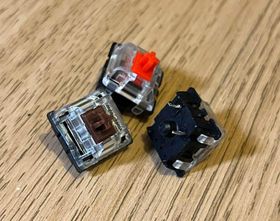
There are lots of manufacturers and limited runs of this switch shape with different colours and actions, and it can get quite overwhelming, but you can just stick to the normal colours!
If you’re not sure what colour you want a lot of places sell a switch tester with a few different colours in so you can get a feel for what you like most.
Which colour you buy is entirely up to you, it’s based on personal preference. What does matter is what shape of switch you buy, and this will usually be specified on the keyboard/PCB listing.
There are other types of switches e.g. low profile switches, but the majority of keyboards and keycaps that I’ve seen are made for the Cherry MX profile.
Keyboards
The keyboard itself can come in lots of different shapes and sizes. You didn’t think this would be simple, did you?
You can buy keyboards as kits ready to be assembled (you'll need some tiny screwdrivers and a soldering iron), or prebuilt. Some places offer assembly service for you, though I think assembly is half the fun!
Keyboard size and shape
Your regular rectangular keyboard can have any number of keys, and some limited edition ones have a truly bizarre layout. I recommend the Switch & Click keyboard size guide for an overview of the most common ones.
When it comes to choosing a size, think about what’s important to you. Do you use the numpad? Better get a compact or a full-sized one. Do you need the F-keys (go 75% or larger) or will you be all right with using a function key and the num row (60-65% will do)? Do you like pain (a 40% is for you)?
I have a KBDFans Tofu84 (75%) at work, and an ikki68 (65%) at home. The F2 key gets a lot of use at work when I’m renaming variables!
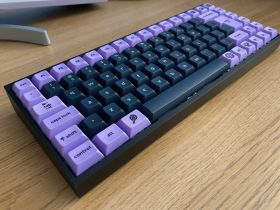
Then there’s the split keyboards, literally split down the middle and connected by a cable. They’re meant to be really great for wrist strain, much better for you posture-wise, though I haven’t tried one myself as I don’t have the energy to re-learn to type. They’re also excellent if you want to look like you come from, or travel regularly to, space.
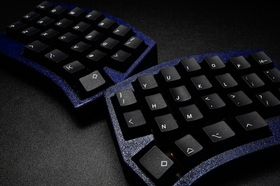
Joking aside, they are supposed to be much better for you. A popular ergo keyboard is the Ergodox, which is actually open source: you can download the files for the PCB from GitHub and get it printed yourself, sourcing whichever compatible parts you like (or 3D printing them). There are also a lot of kits or pre-made versions if you prefer.
Then there's macropads, tiny and adorable mini keyboards that are a great way to get used to building keyboards if you don't have much experience soldering. I've got a keeb.io BDN9 and a mint-coloured Owlab Voice Mini which is the cutest thing. They both have rotary encoders (knobs) on them which make them 100% more satisfying, but unfortunately I keep forgetting what I've programmed the keys to do so I find I rarely use them.
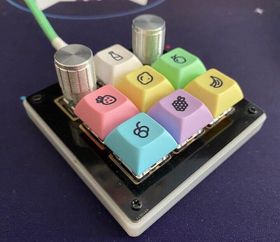
Keyboard layouts: ISO, ANSI, JIS, ortholinear
The most common keyboard layout I’ve seen is the ANSI layout, which is the standard keyboard layout in the US. It’s characterised by its flat enter key, longer shift key on the left, and extra key above the enter key.
ISO is generally used in Europe, and has a delightfully chunky enter key that’s two rows high, with a smaller left shift key (two keys where ANSI has one).
JIS is the Japanese International Standard, and has an extra key next to backspace, an ISO-style enter key, and a smaller right shift key.
Mechkeys has an article about these common layouts, including some diagrams.
I know plenty of folks in Europe who use ANSI layout simply because the keyboards are more common, but I much prefer ISO. Generally, keyboard kits and PCBs will say which layouts they support; often they support multiple configurations so you could even mix and match, say, an ISO enter key and a US-style left shift.
Finally we have the ortholinear layout. These are quite amazing looking, a bit like a long Boggle. Unlike regular keyboards which have staggered rows, the keys are all aligned in a grid. Read more about ortho keyboards on Try Ortho Keys.
Typing angle
Perhaps a minor one, but this may make a difference to you; different keyboards are set at different angles, and unlike your 2001 Compaq keyboard most of these mechanical ones don’t have those little fold-out feet that you snapped off while waiting for the dialup to connect. Most keyboard listings will tell you the typing angle.
Dampening sound
If you’re like me, you want to minimise the sound from a keyboard as much as possible, especially in the office. There are a few ways of doing that:
- use quieter switches (red, black)
- use silent switches (NB these are quieter, not actually silent)
- put O-rings on your keycaps (I got some cheap off eBay)
- line your case with foam to absorb sound
- put a desk mat underneath your keyboard
Keycaps
The most exciting bit, I reckon. The bits with the letters on that are prettier than they have any right to be. You can get retro ones, cute pastel ones, dark ones with light writing... the possibilities are endless.
Some of my favourite keysets of recent years:
- DSA Milkshake
- ePBT Dreamscape
- KAT Space Dust (this has been delayed forever, bah)
- Mintlodica Pastel Dreams
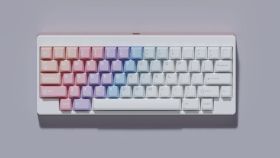
Kits
Keycaps will usually have different kits on sale, so check the listing carefully to see what each one contains. You'll definitely want to get the base kit (with all the alphanumeric keys and ANSI keys). Sometimes you have to buy the ISO kit separately for the big enter key and some Europe-specific keys like the UK 3 (# and £). Often sets will do a novelties kit: Milkshake had a set of pastel-coloured keys with fruit legends, and Dreamscape has novelties with stars, clouds and meteors. I always enjoy the novelties.
Materials
Keycaps are generally plastic, except for the occasional novelty one. They’re either made of PBT or ABS; PBT is nicer but ABS is cheaper. The sets you get with your off-the-shelf keyboard, or off AliExpress, are probably ABS. It’s more flexible, but the legends can wear off the surface of the keycaps.
Additionally, keycaps may be “double shot” (two layers of plastic, one for the lettering and one for the overlay).
Keycaps can come in a variety of different profiles, and may be flat (all one height) or sculpted (different rows have different heights). Different profiles have different heights. Generally I’m not fussy about profiles, I just accept whatever profile they’ve chosen for the keyset I’m after.
Check out The Keeblog’s article about different keycap profiles for a full overview.
Key sizes
The keys themselves are measured in units (u): your average letter or number key is 1u wide, and everything else is relative to that. Most keysets will come with various different lengths for backspace, shift and caps lock keys which you might use depending on the layout of your keyboard. Some folks like a split spacebar; this is a must if you’ve got a split ergonomic keyboard, as you’ll need one on each side.
Check out Keyboard University’s guide to keycaps.
How to actually buy keyboards and keycaps
You can buy most switches in large enough quantities from wherever (even eBay), but many keyboards or keycaps require a bit more effort.
The group buy process
Since it’s a niche hobby, there isn’t enough demand for all of these things to just be mass-produced. Many keyboards, and most keysets, will go through a process called group buy, where a certain number of sets need to be sold before production can go ahead.
Generally things will go through interest checks (ICs) before this stage, to gauge how much interest there is in the first place. Designers will produce very lifelike renders of the proposed keyset or keyboard, and if there’s enough interest they’ll approach a manufacturer. There will be a minimum order quantity, so they’ll have to guarantee a certain number of sales before production can go ahead. Production generally happens in China, and takes many months (especially if there are lots of sets in the queue in front of it).
This is where the group buy phase begins. Various vendors around the world will agree to be the distributors for the set; this means you buy the set through the vendor, and the vendor in turn places an order for a certain number of sets from the manufacturer. The group buy phase has a limited time period, though usually there are no limits on how many units are available. A warning: generally there are no refunds on group buys because they need to guarantee the order quantity.
Once the group buy is over, production can begin. The factory will produce a sample set which will go back to the designer to see if they’re happy with it, and this can happen a few times until the designer is happy. Finally, it’ll go into full production, and eventually distribution. The sets will be shipped to the vendor and they’ll be in charge of shipping them to their customers.
Vendors should provide updates with how things are progressing, but there are often delays. Group buys generally have a ship date of a particular quarter rather than a specific month (e.g. Q3 2024) but this is subject to change.
Most vendors will have a list of upcoming and current group buys on their website; see “Where to buy” below.
If you missed out on a group buy, don't despair. Sometimes creators will do re-runs or new revisions of popular keysets/keyboards.
What to buy if you want it now
If you genuinely don’t care about group buys and want something right away (fair play), consider checking out a Keychron. It’s a solid choice and readily available. It definitely doesn’t fulfil the “pretty” requirement, but it’s nice to type on and won’t set you back as much as the custom ones. You can swap out the keycaps and many of them are hot-swappable.
A lot of keyboard retailers will have some keyboards and keysets in stock most of the time, including the “extras” that are additional sets they ordered from a group buy to sell on. These tend to go quite quickly, so if you missed a group buy make sure you pay attention to when the extras will be in stock and act fast.
Where to buy
There’s a very comprehensive list of keyboard vendors by Alexotos. My personal (UK) faves are Prototypist (for group buys) and Mechboards for in-stock kits and accessories. I buy switches from Mechboards or eBay.
If you're not sure about a vendor, check out one of the mechanical keyboard discord servers and ask around for reviews. I find people are generally pretty helpful.
As always, prepare to be hit by customs charges when ordering from abroad. That includes ordering from the EU to the UK (sob). Ordering from local vendors doesn't incur customs fees as these are shipped locally, though generally the customs charges will be factored into the group buy price.
Further reading & links
- Keyboard University – a beginner’s guide to all things mechanical keyboards
- Cute Keyboard Club – a discord server about adorable mechanical keyboards and all sorts of other things
- Mintlodica – one of my favourite creators of beautiful cute keycaps and keyboards
- KBDFans make some of the best keyboards out there, including my personal favourite Tofu65. They're based in China, so watch out for customs fees.